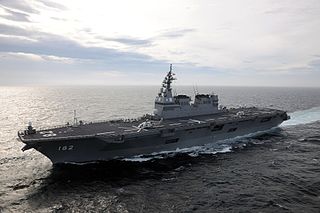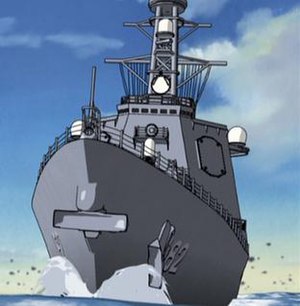
The RUR-5 ASROC is an all-weather, all sea-conditions anti-submarine missile system. Developed by the United States Navy in the 1950s, it was deployed in the 1960s, updated in the 1990s, and eventually installed on over 200 USN surface ships, specifically cruisers, destroyers, and frigates. The ASROC has been deployed on scores of warships of many other navies, including Canada, Germany, Italy, Japan, Taiwan, Greece, Pakistan and others.

The Spruance-class destroyer was developed by the United States to replace the many World War II–built Allen M. Sumner- and Gearing-class destroyers, and was the primary destroyer built for the United States Navy during the 1970s and 1980s. It was named in honor of U.S. Navy Admiral Raymond A. Spruance, who successfully led major naval battles in the Asiatic-Pacific Theater during World War II such as the Battle of Midway and the Battle of the Philippine Sea.

The Kongō class of guided-missile destroyers in the Japan Maritime Self-Defense Force are equipped with the Aegis Combat System, and is the first of few ship classes outside the United States to have that capability. Following a decision made in December 2003, Japan is upgrading their Kongo-class destroyers with Aegis Ballistic Missile Defense System. The upgrade involves a series of installations and flight tests to take place from 2007 to 2010. JS Kongo was the first ship to have the BMD upgrade installed.

The Japan Maritime Self-Defense Force, abbreviated JMSDF, also simply known as the Japanese Navy, is the maritime warfare branch of the Japan Self-Defense Forces, tasked with the naval defense of Japan. The JMSDF was formed following the dissolution of the Imperial Japanese Navy (IJN) after World War II. The JMSDF has a fleet of 154 ships, 346 aircraft and 50,800 personnel.

Destroyer leader (DL) was the United States Navy designation for large destroyers from 9 February 1951 through the early years of the Cold War. United States ships with hull classification symbol DL were officially frigates from 1 January 1955 until 1975. The smaller destroyer leaders were reclassified as destroyers and the larger as cruisers by the United States Navy 1975 ship reclassification so destroyer escorts could be reclassified as frigates (FF) in conformance with international usage of the term.

Zipang is a Japanese manga series written and illustrated by Kaiji Kawaguchi. It was serialized in Kodansha's seinen manga magazine Morning from 2000 to 2009, with its chapters collected in forty-three tankōbon volumes. It tells the story of the members of the Japan Maritime Self-Defense Force who are transported back in time more than 60 years to 1942.

The Sejong the Great-class destroyers, also known as KDX-III, are three guided-missile destroyers of the Republic of Korea Navy (ROKN).

The Atago class of guided-missile destroyers in the Japan Maritime Self-Defense Force is a modified version of the Kongō class equipped with the Aegis Combat System.

The Murasame-class destroyer is a class of destroyers, serving with the Japan Maritime Self-Defense Force (JMSDF). This is the first class of the second-generation general-purpose destroyers of the JMSDF.

The Haruna-class destroyer was a destroyer class built for the Japan Maritime Self-Defense Force (JMSDF) in the early 1970s. These helicopter carrying destroyers (DDH) were built around a large central hangar which housed up to three helicopters.

The Asagiri-class destroyer is a class of destroyer, serving with the Japan Maritime Self-Defense Force (JMSDF). It was the second class of first-generation general-purpose destroyers of the JMSDF.

JDS Amatsukaze (DDG-163) was a guided missile destroyer (DDG) of the Japan Maritime Self-Defense Force (JMSDF), and the only ship of her class. She was the first Japanese surface combatant equipped with surface-to-air missiles.

The Hyūga-class helicopter destroyer is a class of helicopter carrier built for the Japan Maritime Self-Defense Force (JMSDF). Two - Hyūga and Ise - were built; upon completion the class were the largest ships built for the Japanese navy since the Second World War. Hyūga was described in a PBS documentary as the "first Japanese aircraft carrier built since WWII".

The Akizuki class of destroyers of the Japan Maritime Self-Defense Force is intended to escort the Hyūga-class and Izumo-class helicopter destroyers, and safeguard the other Aegis-capable warships such as the Kongō class and Atago class. The destroyer provides defense against surface, airborne and undersea threats. The class was initially designated as "19DD", referring to a date on the Japanese calendar, specifically the 19th fiscal year of the Heisei period (2007).

The aircraft cruiser is a warship that combines the features of the aircraft carrier and a surface warship such as a cruiser or battleship.

JS Ashigara (DDG-178) is an Atago-class guided missile destroyer in the Japan Maritime Self-Defense Force (JMSDF). Ashigara was named for Mount Ashigara, and is the first Japanese ship to bear the prefix JS instead of JDS.

JS Ise (DDH-182) is a Hyūga-class helicopter destroyer of the Japan Maritime Self-Defense Force (JMSDF). It is the second ship to be named Ise, the first being the Imperial Japanese Navy World War II-era battleship Ise.

JS Hiei (DDH-142) was the second ship of the Haruna-class helicopter destroyer of the Japanese Maritime Self Defense Force.

The Maya class of guided-missile destroyers in the Japan Maritime Self-Defense Force is a modified version of the Atago class, with an updated Aegis Combat System and electric propulsion system. Maya was commissioned on March 19, 2020. Haguro was commissioned on March 19, 2021.





















